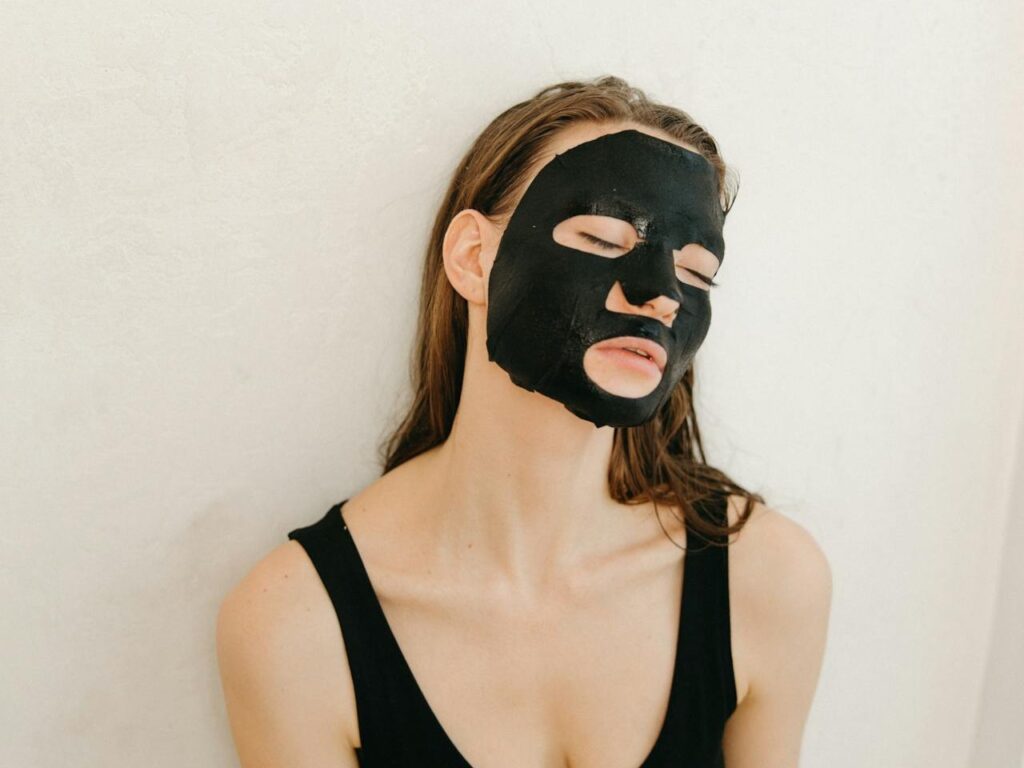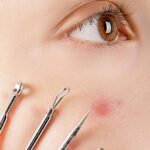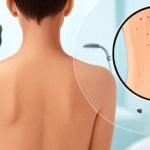Blackheads on your chin can be frustrating and persistent, but understanding their root causes and implementing the right treatment approach can help you achieve clearer skin. This comprehensive guide explores why blackheads specifically target the chin area and provides evidence-based solutions for both treatment and prevention.
Understanding Blackheads: What Are They Exactly?
Blackheads, medically known as open comedones, are a mild form of acne that occurs when hair follicles become clogged with a combination of sebum (natural skin oil), dead skin cells, and bacteria. Unlike whiteheads, which remain closed under the skin’s surface, blackheads have an opening that allows the trapped material to oxidize when exposed to air, creating their characteristic dark appearance.
The chin area is particularly susceptible to blackheads due to several anatomical and physiological factors:
- Higher concentration of sebaceous glands that produce more oil
- Larger pore size compared to other facial areas
- Frequent contact with hands, phones, and face masks
- Hormonal sensitivity that affects oil production in the lower face
Primary Causes of Chin Blackheads
Excess Sebum Production
The chin and jawline contain numerous sebaceous glands that can become overactive due to various triggers. When these glands produce more oil than your skin can naturally shed, it creates the perfect environment for blackhead formation. This excess sebum mixes with dead skin cells and becomes trapped in hair follicles.
Hormonal Fluctuations
Hormonal changes significantly impact chin blackheads, particularly in women. The lower face, including the chin and jawline, is especially sensitive to hormonal fluctuations during:
- Menstrual cycles: Increased androgen levels before menstruation stimulate oil production
- Pregnancy: Hormonal surges can trigger increased sebum production
- Menopause: Declining estrogen levels can worsen acne in the chin area
- PCOS (Polycystic Ovary Syndrome): Elevated androgen levels commonly cause chin and jawline breakouts
Bacterial Overgrowth
Propionibacterium acnes (P. acnes) bacteria naturally live on your skin but can multiply rapidly in clogged pores. These bacteria feed on sebum and dead skin cells, creating an inflammatory environment that can worsen blackheads and potentially lead to more severe acne lesions.
Lifestyle and Environmental Factors
Several daily habits and environmental factors specifically contribute to chin blackheads:
- Phone contact: Pressing your phone against your chin transfers bacteria and oil
- Face mask wearing: Extended mask use can trap moisture and bacteria around the chin
- Touching and picking: Frequent hand-to-face contact introduces bacteria and can worsen existing blackheads
- Dietary factors: High-glycemic foods and dairy products may exacerbate hormonal acne patterns
- Stress: Elevated cortisol levels can increase oil production and worsen acne
Age-Related Factors
Blackhead patterns on the chin can vary significantly by age group:
- Teenagers: Hormonal surges during puberty often cause widespread blackheads, including the chin
- Adults (20s-30s): Stress, hormonal birth control, and lifestyle factors commonly affect the chin area
- Mature adults (40+): Hormonal changes during perimenopause and menopause can trigger new chin blackhead patterns
Effective Treatment Options for Chin Blackheads
Over-the-Counter (OTC) Treatments
Salicylic Acid (Beta Hydroxy Acid)
Salicylic acid is particularly effective for chin blackheads because it’s oil-soluble, allowing it to penetrate deep into pores. It works by:
- Dissolving the bonds between dead skin cells
- Reducing oil production
- Providing anti-inflammatory benefits
Recommended concentration: Start with 0.5-1% and gradually increase to 2% as tolerated.
Benzoyl Peroxide
This antimicrobial agent targets the bacterial component of blackheads while also helping to unclog pores. It’s especially beneficial when blackheads are accompanied by inflammatory acne.
Usage tip: Start with 2.5% concentration to minimize irritation, and always use sunscreen as benzoyl peroxide increases photosensitivity.
Retinoids (Adapalene/Differin)
Now available over-the-counter, adapalene is highly effective for preventing new blackheads by normalizing skin cell turnover and preventing pore blockages.
Application: Use once daily in the evening, starting every other night to build tolerance.
Professional Treatment Options
Chemical Peels
Professional chemical peels using glycolic acid, salicylic acid, or combination formulations can effectively address stubborn chin blackheads by:
- Removing multiple layers of dead skin cells
- Deeply unclogging pores
- Stimulating cellular renewal
Extraction Procedures
Professional comedone extraction by a dermatologist or licensed aesthetician is the safest method for removing deep, stubborn blackheads. This procedure uses specialized tools to safely remove blackhead contents without causing scarring or spreading bacteria.
Laser and Light Therapies
Advanced treatments like IPL (Intense Pulsed Light) and laser therapy can help reduce oil production and target bacteria, providing long-term improvement for chronic chin blackheads.
Prescription Treatments
For persistent or severe chin blackheads, dermatologists may prescribe:
- Topical retinoids (tretinoin, tazarotene): More potent than OTC versions
- Topical antibiotics: To address bacterial overgrowth
- Hormonal therapy: Birth control pills or spironolactone for hormonally-driven chin blackheads
- Oral antibiotics: For cases with significant inflammatory component
Prevention Strategies Specifically for Chin Blackheads
Daily Skincare Routine
Morning Routine:
- Gentle cleanser with salicylic acid
- Lightweight, non-comedogenic moisturizer
- Broad-spectrum SPF 30+ sunscreen
Evening Routine:
- Double cleansing (oil cleanser followed by water-based cleanser)
- Treatment product (retinoid or BHA)
- Non-comedogenic moisturizer
Lifestyle Modifications
- Phone hygiene: Clean your phone screen daily with alcohol wipes
- Mask care: Change disposable masks frequently and wash reusable masks after each use
- Hands-off approach: Avoid touching your chin throughout the day
- Pillowcase hygiene: Change pillowcases every 2-3 days
- Hair products: Keep hair products away from the chin area
Dietary Considerations
While research is ongoing, some studies suggest that certain dietary modifications may help reduce chin blackheads:
- Limit high-glycemic foods: Reduce refined sugars and processed carbohydrates
- Consider dairy reduction: Some individuals see improvement when limiting dairy intake
- Increase omega-3 fatty acids: Found in fish, walnuts, and flaxseeds
- Stay hydrated: Adequate water intake supports overall skin health
When to See a Dermatologist
Consider professional consultation if you experience:
- Persistent blackheads that don’t respond to 8-12 weeks of consistent OTC treatment
- Deep, painful blackheads that may require professional extraction
- Scarring or dark spots from previous blackhead removal attempts
- Hormonal patterns suggesting underlying hormonal imbalances
- Widespread acne beyond just blackheads
- Emotional distress related to your skin condition
Treatment Timeline and Expectations
Understanding realistic timelines helps maintain consistent treatment:
- Weeks 1-2: Initial adjustment period, possible temporary worsening
- Weeks 4-6: Beginning to see reduction in new blackhead formation
- Weeks 8-12: Significant improvement in existing blackheads
- 3-6 months: Optimal results with consistent treatment
Remember that consistency is key – sporadic treatment often leads to disappointing results.
Common Mistakes to Avoid
- Over-cleansing: Washing more than twice daily can increase oil production
- Aggressive scrubbing: Physical exfoliation can worsen blackheads and cause irritation
- Squeezing blackheads: This can lead to scarring, infection, and spread of bacteria
- Using too many active ingredients: Combining multiple treatments can cause irritation
- Inconsistent routine: Sporadic treatment prevents optimal results
The Bottom Line
Chin blackheads are a common but treatable skin concern that requires a targeted, consistent approach. By understanding the specific causes that affect the chin area – from hormonal fluctuations to lifestyle factors – you can develop an effective treatment strategy that addresses your individual needs.
Start with a gentle but consistent routine using proven ingredients like salicylic acid and retinoids, while making lifestyle modifications to prevent future blackheads. If over-the-counter treatments don’t provide adequate results after 12 weeks, don’t hesitate to consult a dermatologist for professional guidance and advanced treatment options.
Remember, achieving clear skin is a journey that requires patience and consistency. With the right approach and realistic expectations, you can successfully manage chin blackheads and maintain healthier, clearer skin long-term.
Frequently Asked Questions
Q: Why do I only get blackheads on my chin and not other areas of my face?
A: The chin area has a higher concentration of sebaceous glands and larger pores, making it more susceptible to blackheads. Additionally, hormonal fluctuations particularly affect the lower face, and the chin experiences more contact with hands, phones, and face coverings.
Q: How long does it take to see results from blackhead treatments?
A: Most people begin to see improvement after 4-6 weeks of consistent treatment, with optimal results typically achieved after 8-12 weeks. However, individual results may vary based on skin type, severity, and treatment consistency.
Q: Is it safe to extract blackheads at home?
A: While gentle extraction with proper tools and technique may be possible for surface blackheads, it’s generally safer to have stubborn or deep blackheads professionally extracted to avoid scarring, infection, or spreading bacteria.
Q: Can diet really affect chin blackheads?
A: While research is still evolving, some studies suggest that high-glycemic foods and dairy products may worsen acne in some individuals. The chin area is particularly sensitive to hormonal changes that can be influenced by diet.
Q: Why do my chin blackheads seem to come back even after treatment?
A: Blackheads can recur because the underlying factors (oil production, dead skin cell buildup, bacteria) are ongoing processes. Consistent prevention through proper skincare routine and lifestyle modifications is essential for long-term management.



